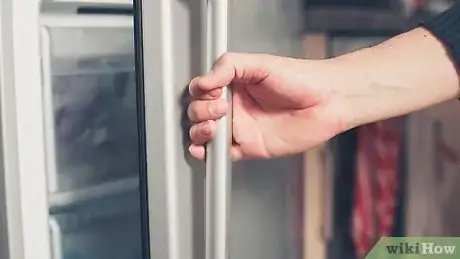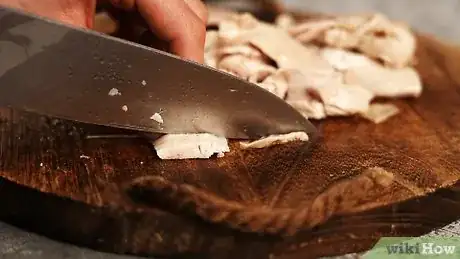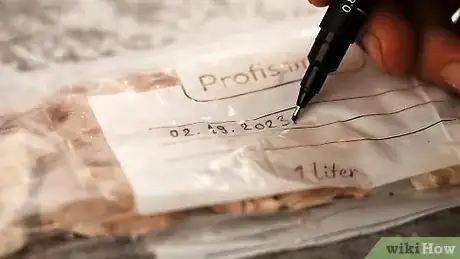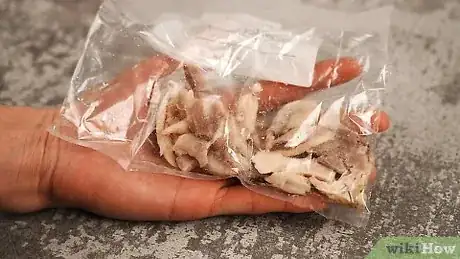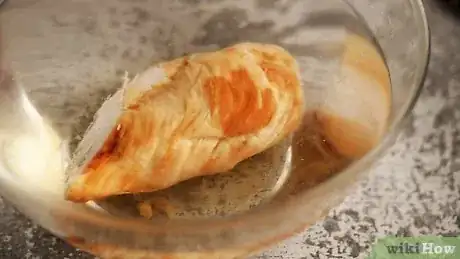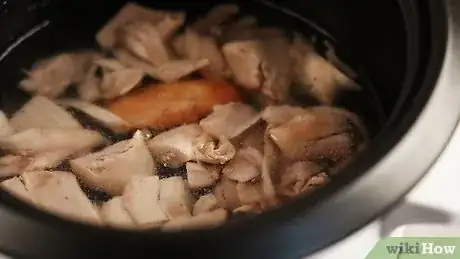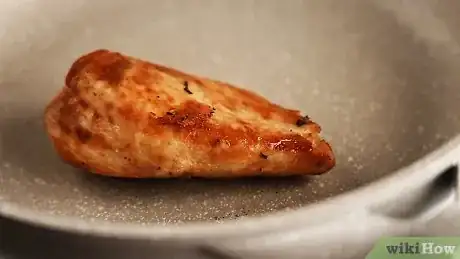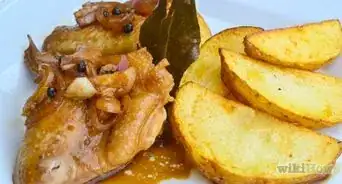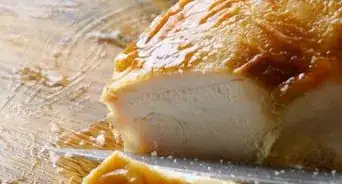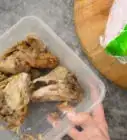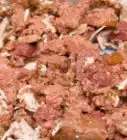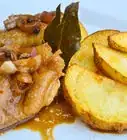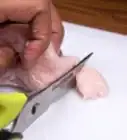This article was co-authored by wikiHow staff writer, Finn Kobler. Finn Kobler graduated from USC in 2022 with a BFA in Writing for Screen/Television. He is a two-time California State Champion and record holder in Original Prose/Poetry, a 2018 finalist for the Los Angeles Youth Poet Laureate, and he's written micro-budget films that have been screened in over 150 theaters nationwide. Growing up, Finn spent every summer helping his family's nonprofit arts program, Showdown Stage Company, empower people through accessible media. He hopes to continue that mission with his writing at wikiHow.
There are 12 references cited in this article, which can be found at the bottom of the page.
The wikiHow Culinary Team also followed the article's instructions and verified that they work.
Learn more...
Accidentally made a little too much chicken for dinner? Not a problem! In addition to being one of the most delicious and versatile foods out there, cooked chicken is totally safe to freeze. Storing your chicken in the freezer will preserve it for months on end. And, since it’s already cooked, the process will be painless! In this article, we’ll break down the most effective way to freeze cooked chicken so the meat will keep and offer advice on how to cook safely when you’re ready to eat it again.
Things You Should Know
- Allow your chicken to cool for approximately 24 hours before storing it in the freezer. Let it sit at room temperature for about an hour. Then, place it in the fridge overnight.
- Peel off any skin and remove any bones before freezing your chicken.
- Cut your chicken into smaller pieces before freezing to make portioning and thawing quicker and easier.
- Flash-freeze your chicken by placing it in the freezer for 1 hour before long-term storage. This will ensure it retains its texture and flavor.
Steps
Cooling and Cutting
-
1Cool your chicken by refrigerating it for 24 hours. To prevent increasing the temperature of your freezer, let the internal and external temperature of your chicken drop down until the meat is cool to the touch. Begin the cooling process by allowing it to sit at room temperature for about an hour first. Then, refrigerate it overnight.[1]
- Refrigerate your chicken no more than 2 hours after cooking to prevent bacterial growth.
-
2Peel off and discard the chicken skin. Once your chicken has cooled, begin peeling off and throwing away all fatty skin. To remove chicken skin, grasp firmly at the joint end of your chicken skin and pull off each whole piece one at a time. If your chicken does not have a joint end (if it’s a drumstick, cutlet, etc.), grab the meatier end and peel.[2]
- If the chicken skin is too difficult to grasp, use a paper towel or try dipping your fingers in salt.
- Don’t worry about pulling the skin off wing tips, joints, and other parts of the chicken that can’t easily be peeled.
Advertisement -
3Remove any chicken bones. If your chicken pieces have bones (thighs, legs, etc.), get rid of them to ensure the meat freezes evenly. Place the chicken on a cutting board skin side down and use a sharp boning knife or chef’s knife to find the bone under the meat. Make a small incision to separate the bone from the meat and use your fingers to pull the bone out.[3]
- You can freeze your bones and use them to make healthy bone broth or chicken stock in the future.
-
4Cut up your chicken into smaller pieces. Slice your chicken into smaller pieces using a chef’s knife or kitchen scissors. Cut your chicken based on the recipes you plan to use chicken for in the future. If you want to make a casserole or soup, bite-sized shreds may be the best option. If you plan on serving them in full breasts or cutlets, just slice off enough so your chicken fits in the containers you plan to use.[4]
- Cutting your chicken ensures your chicken will freeze more evenly. Plus, reheating it is more convenient since you won’t have to thaw full breasts.
Freezing and Storing
-
1Flash-freeze the chicken for 1 hour. After you’ve cooked and cut your chicken, lay your chicken pieces in a flat, single layer on a baking sheet. Place the baking sheet in your freezer for 1 hour until the pieces begin hardening. This will ensure your chicken retains its texture and flavor.[5]
- Flash-freezing also ensures your chicken pieces won’t stick together since they’ll be quickly chilled individually and ice crystals will remain small when you place them in the freezer for longer storage.
-
2Portion your chicken and seal each serving in plastic wrap. After you’ve flash-frozen your chicken, portion your chicken in servings of 1-2 cups each (or whichever serving size is appropriate for the recipes you’ve planned). Then, wrap each portion in saran wrap to lower the risk of freezer burn.[6]
- If you don’t have enough containers, tightly wrap your chicken pieces in aluminum foil and place them on an aluminum foil tray.
-
3Place your chicken in plastic bags or containers and label/date them. Begin placing each wrapped chicken portion in airtight Ziplock bags or plastic containers. Label and date your containers with a marker to prevent confusion and ensure you know how long you have to eat your chicken.[7]
- If you plan on freezing multiple layers of chicken pieces in one container, add a layer of freezer paper between them to make thawing faster.
-
4Freeze your chicken at 0 °F (−18 °C). Place your containers inside your freezer. Check the temperature regularly and make sure it does not rise above freezing level for the entire time you freeze your cooked chicken.[8]
- If the power goes out on your freezer, eat your food within 24 hours before it spoils.
-
5Keep your chicken frozen for no more than 4 months. While raw chicken can be frozen for nearly a year, the USDA states that frozen cooked chicken tastes best if it is stored at 0 degrees for no longer than 4 months total. Keep an eye on the date of your containers and find a recipe for your cooked chicken to use within 120 days.[9]
- Chicken patties and nuggets should be frozen for no longer than 3 months.
- Chicken that’s heavily marinated/covered in a broth or gravy can be frozen for up to 6 months.
Reheating
-
1Cut off any freezer burned parts of your chicken. Storing your chicken in the freezer for a long period of time may result in freezer burn. Inspect your chicken before thawing for excessively colorless or gray spots as these are signs of freezer burn, which kills flavor and promotes bacteria growth. Freezer burn does not cause spoilage to the whole meat, so merely cut off all freezer burned portions of the chicken with a knife and discard them.[10]
- In areas near the old chicken bones, color changes may not be a sign of freezer burn. It’s normal for leftover pigment to seep through the porous bone tissue into nearby parts of the poultry.
-
2Thaw your chicken in a microwave, fridge, or cold water bath. There are several ways to defrost your cooked chicken when you’re ready to eat it again. If you have some time and want to retain as much flavor as possible, transfer your chicken from the freezer to the fridge and let it defrost for approximately 24 hours. If you’re in a hurry, place the frozen chicken in a bowl of cold water or directly into the microwave and use the defrost setting.[11]
- If you decide to thaw your chicken in the microwave, open the microwave door and check the chicken’s temperature regularly to ensure it does not begin cooking in there.
- Avoid using a slow cooker to thaw your chicken as the heat may promote bacteria growth and spoil your meal.
-
3Reheat your chicken in the oven if it’s a breast or larger. To cook your chicken from frozen, preheat your oven to 350 °F (177 °C) and season the meat while the oven warms up. Then, place your chicken in the oven for 30-45 minutes, checking the internal temperature of the meat regularly and removing it once it reaches 165 degrees fahrenheit.[12]
- Ovens are usually the best option for reheating your chicken if you have a larger piece like a breast or a thigh.
-
4Reheat your chicken in a crock pot if it’s in small pieces. To re-cook your chicken using a crockpot, place your chicken in the crockpot with olive oil, salt, pepper, and other desired spices. Cook on medium heat for 5-6 hours or high heat for 2-3 hours.[13]
- Reheating your chicken in a crockpot is a great idea if you plan on making stews, soups, dumplings or other meals where smaller pieces of chicken can be used as a filling.
-
5Reheat your chicken on a stovetop if it’s cutlet size. If you wish to cook your chicken using a stovetop, place the chicken on a 10 inches (25 cm) nonstick skillet and let the meat bake on medium-high heat for about 6-7 minutes (or until the bottom layer becomes golden brown). Then, flip the chicken over and cook for an additional 4-5 minutes.[14]
- Spray your skillet with a non-stick oil before cooking to prevent the chicken from attaching to the pan.
References
- ↑ https://ohioline.osu.edu/factsheet/HYG-5334/
- ↑ https://www.goodhousekeeping.com/food-recipes/cooking/tips/g1706/remove-chicken-skin/?slide=5
- ↑ https://www.foodnetwork.com/how-to/articles/how-to-debone-chicken-a-step-by-step-guide
- ↑ https://extension.missouri.edu/publications/gh1504
- ↑ https://www.bhg.com/recipes/how-to/cooking-basics/how-to-flash-freeze-foods/
- ↑ https://ohioline.osu.edu/factsheet/HYG-5334
- ↑ https://extension.missouri.edu/publications/gh1504
- ↑ https://www.fsis.usda.gov/food-safety/safe-food-handling-and-preparation/food-safety-basics/freezing-and-food-safety
- ↑ https://ask.usda.gov/s/article/How-long-can-you-freeze-chicken
- ↑ https://www.fsis.usda.gov/food-safety/safe-food-handling-and-preparation/food-safety-basics/freezing-and-food-safety
- ↑ https://www.fsis.usda.gov/food-safety/safe-food-handling-and-preparation/poultry/chicken-farm-table#13
- ↑ https://www.food.com/recipe/easy-frozen-chicken-breast-265634
- ↑ https://www.fsis.usda.gov/food-safety/safe-food-handling-and-preparation/food-safety-basics/slow-cookers-and-food-safety
- ↑ https://www.mayoclinic.org/healthy-lifestyle/recipes/southwest-chicken-and-beans/rcp-20125118
